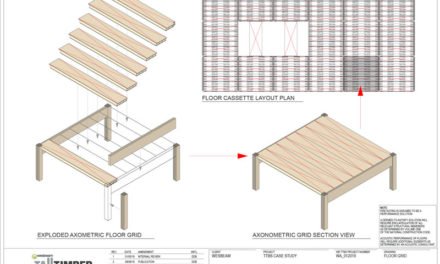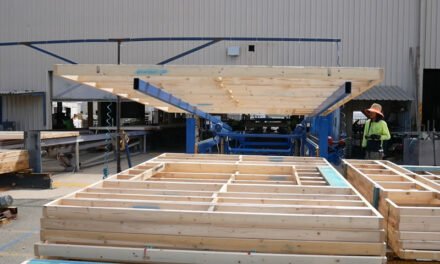Whether durability, beauty or practicality is your goal, timber cladding makes it child’s play.
Timber cladding product has always been popular in residential builds, but recently it’s been given more space to shine in high-end architectural applications.
One of the industry figures pushing this move is Michael Kennedy of Kennedy’s Timbers. “We talk to a lot of architects about what timber can do,” he says. “They’re often looking for products that are durable and sustainable, that they can use in applications where people don’t want to do a lot of maintenance. We introduce them to timber products that tick all those boxes.”
Traditionally, commercial, public and educational projects used concrete or steel or, more recently, panelised cladding. But safety and environmental concerns have come to the fore, giving Kennedy and like-minded suppliers a chance to show how hardwoods weather off attractively and have impressive natural durability.
“Wood has such a low carbon footprint and such a great environmental story that we’re seeing universities across the nation swing back towards it,” says Kennedy. “Through good design, you can have a low-maintenance timber option for exterior use that’s going to last 25+ years.”
Recent architectural awards lists have shown the fruits of these efforts, with timber exteriors and interiors featuring in a high percentage of structures beyond just residential. It’s a change hastened by coatings specialists introducing products that deliver easy upkeep and maintenance for all solid, engineered and modified wood types, helping to lower ongoing costs while keeping buildings looking their best.
Case study
One example of how timber cladding can lift all parts of a building is the Margaret Cribb Early Learning centre at the University of Queensland, which was shortlisted for the 2018 Queensland Architecture Awards.
“We were approached by dwp Design Worldwide Partnership to consult on a project,” says Kennedy. “Their brief asked for a product that needed little maintenance, would be durable and look good.”
Geoff Street, Queensland managing director for dwp, says the call for timber, particularly recycled timber, was based on the facility’s Reggio Emilia philosophy of early childhood learning. “It’s about aligning the environment as part of the children’s education,” he says. “Both the external environment the building is sited within and the internal environment they’re learning in: there’s a blurred line between them.
“Recycled timber both reflected the natural, wooded setting at the entrance to the University of Queensland and embraced the sustainability that’s a core element of this philosophy.”
After investigating multiple options, Kennedy’s and dwp chose highly durable spotted gum cut from recycled power poles for exterior and interior cladding, as well as decking and some floors.
“Universities often have a focus on low maintenance and low recurrent costs,” says Street, “so we had to convince them timber was an appropriate solution.”
Much of this was done though the work of David Brian, the project architect from inception to completion. “The choice of the spotted gum inside and out was all about giving not just the feeling that the interior belongs with the exterior,” he says, “but also to enhance the children’s experience by giving them texture – something to run their hands across that doesn’t feel like plasterboard.”
As a material that’s used domestically, timber didn’t just create a sense of comfort for the children, all parties knew it could stand up to the significant cleaning and wear requirements of many small hands and feet.
Beyond the boards
As well as meeting the practical needs of the brief, timber helped the architects to practically implement several creative aspects of the building’s design.
“We put our kids’ hats on and tried to imagine what sort of space it might be for the child,” says Brian. “There are deliberate attempts in the architecture to respond to children’s low sightlines, so things don’t feel so big and it’s a more relatable scale. The materials have a combination of different textures both to look at and touch. Timber played a wonderful part in this project in fulfilling both roles.”
The building’s large triangular windows have seating nooks inside, with low, child-friendly sections at their centres. Outside their lines are echoed and continued by a rebated line zigzagging around the cladding.
“That rebate was really purposeful to break up the two different approaches to how we clad the façade with the spacing,” says Brian. “It’s all about creating shadows. The base is literally just standard boards with secret fixings on the edges. The team actually did the routing after those boards were installed – they got the router up there on scaffolding and did a pretty amazing job.”
After the routing, battens were applied, spaced differently above and below the line, which sits on an angle to prevent water collection. “As the sun moves across, it creates different shadows, so all of a sudden you see different shapes,” says Brian.
Educational process
While accolades for timber-clad buildings like this flow readily, architecture in most of Australia’s educational sector is still dominated by traditional hard surfaces, which, in a wry twist, Brian suggests could be down to universities.
“Timber training for architects is little to none,” he says. “Admittedly, I went into a commercial practice after graduating, where we didn’t use timber that often, but when I sit down and talk with Michael, I realise how little I know about timber.”
dwp is just one of the architectural firms with whom Kennedy regularly consults. “We start out with a presentation and lunch at their offices or a tour through our facilities,” Kennedy says. “We put on everything from casual meetings to CPD presentations where we tell them about wood – the environmental story, technical information, samples, whether it suits a particular application. In our experience, architects are very smart and just need information. Once they’ve got that, they can make an assessment on whether or not a product is good for the application they’re looking at.”
The cost is something that Kennedy is personally happy to wear. “What we want to see is more wood used and wood used well,” he says. “We don’t want to see it being used badly or the wrong wood in the wrong application.”
Out of these events, a number of long-term relationships have grown. Kennedy says, “It’s been the basis of a great partnership with dwp and with other architects whereby we see ourselves as a source for them when they have questions or require technical information, or want to know if timber suits a particular application.
“The factory tours are always fantastic for architects because they can see the wood, they can touch it, they can understand and get first-hand experience about how it processes through our operation and what it can bring to their designs.”
Brian very much appreciates the service. “I think there’s a great gap that Michael’s filling,” Brian says. “Yes, he’s promoting his business, but it’s also a good service to our industry to learn more about timber.”
Technology leaders
Beyond traditional hardwoods such as spotted gum, specialist treatments including Accoya acetylated wood and thermo-treated timber products are opening up the cladding market and providing beautiful and long-lasting results, as are coatings designed to dramatically increase the longevity of less-durable timbers in domestic applications.
However, a degree of specificity is required when it comes to getting the best performance out of coatings for some of these newer timber products.
“The process of thermally modifying timber reduces its hygroscopicity,” says Douglas Curr, technical sales and specifications manager at Intergrain Trade & Industrial. “This essentially ‘locks’ the cells to heavily reduce the uptake and release of moisture, which stabilises the timber. But it doesn’t provide any protection from UV rays that ultimately lead to colour degradation.”
He strongly advises using an oil or coating product containing some pigment. “In terms of our product range, Intergrain has done extensive long-term testing at our three Australian exposure sites and we know that our Ultradeck Timber Oil and Timber Stain demonstrate exceptional durability on this substrate,” Curr says.
For Accoya, which is manufactured in the Netherlands, Curr recommends a European coating. “Teknos is one of the world’s leading industrial coating manufacturers and has a long association of working with Accsys Technologies to develop coating systems particularly suited to the Accoya wood substrate,” he says. “The Teknos coating system is based on a specific water-based primer that’s also compatible with most products within the Cabots, Feast Watson and Intergrain brands.”
Compatibility can be a sticking point when it comes to coatings: traditionally systems have been either oil or water based and can only be over-coated with a matching system. A new product, Intergrain Trade & Industrial Universal Timber Oil, overcomes this barrier.
“A lot of our customers prefer to sell pre-oiled timbers for cladding and decking, as they have multiple benefits,” says Will Keaney, senior brand manager at Intergrain Trade & Industrial. “But consumers are frustrated that some products in the market can only be top-coated with themselves – they’re a locked system. We wanted to address this frustration head-on, and empower the consumer to make the choice of a water-based or oil-based finish for their timber.”
Intergrain’s dedicated innovation team, based in Clayton, Victoria, developed Intergrain Trade & Industrial Universal Timber Oil, which can be overcoated with most water-based and oil-based timber oils. While – like so many great ideas – it seems obvious and necessary once you hear about it, “There are no shortcuts in developing new technology. It was developed through months and months of R&D and field testing,” Keaney says.
For the large number of cladding, decking and screening suppliers who offer pre-oiling, it offers a unique value-add. “Intergrain Trade & Industrial Universal Timber Oil gives them a great pre-oiling offering that will save their clients time, money and headaches onsite,” says Brad Pascoe, national business development manager.
“Our customers can take their timber decking, cladding and screening to market with the best possible protection right from the start. The ability to overcoat with most oil- or water-based timber oils puts the choice of topcoat squarely back in the hands of customers and consumers,” he adds.
And aside from changing the supply order, the majority of suppliers offering pre-oiling won’t need to make any other adjustments. “There’s no difference to running any other oil-based product through a Ceetec machine,” Curr says. He adds that the lightly pigmented Intergrain Trade & Industrial Universal Timber Oil is ideal under Ultradeck product for thermally modified timbers.
For more information, visit www.kennedystimbers.com.au, www.dwp.com and www.intergrain.com.au
Image: A line was routed across the timber boards of the Margaret Cribb Early Learning centre façade to mark the change in the cladding. Image by Roger D’Souza Photography, courtesy dwp












